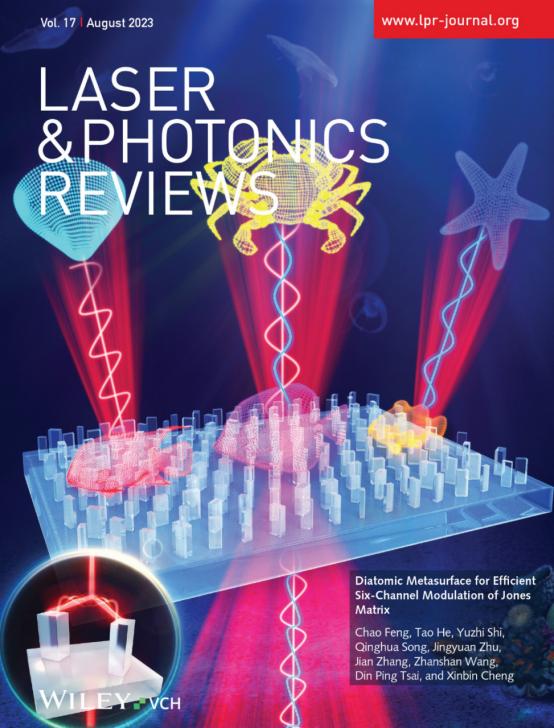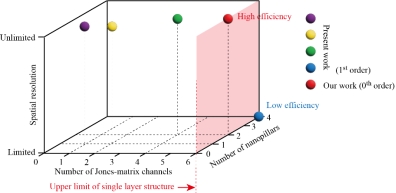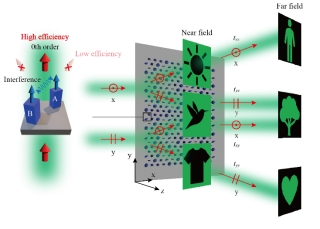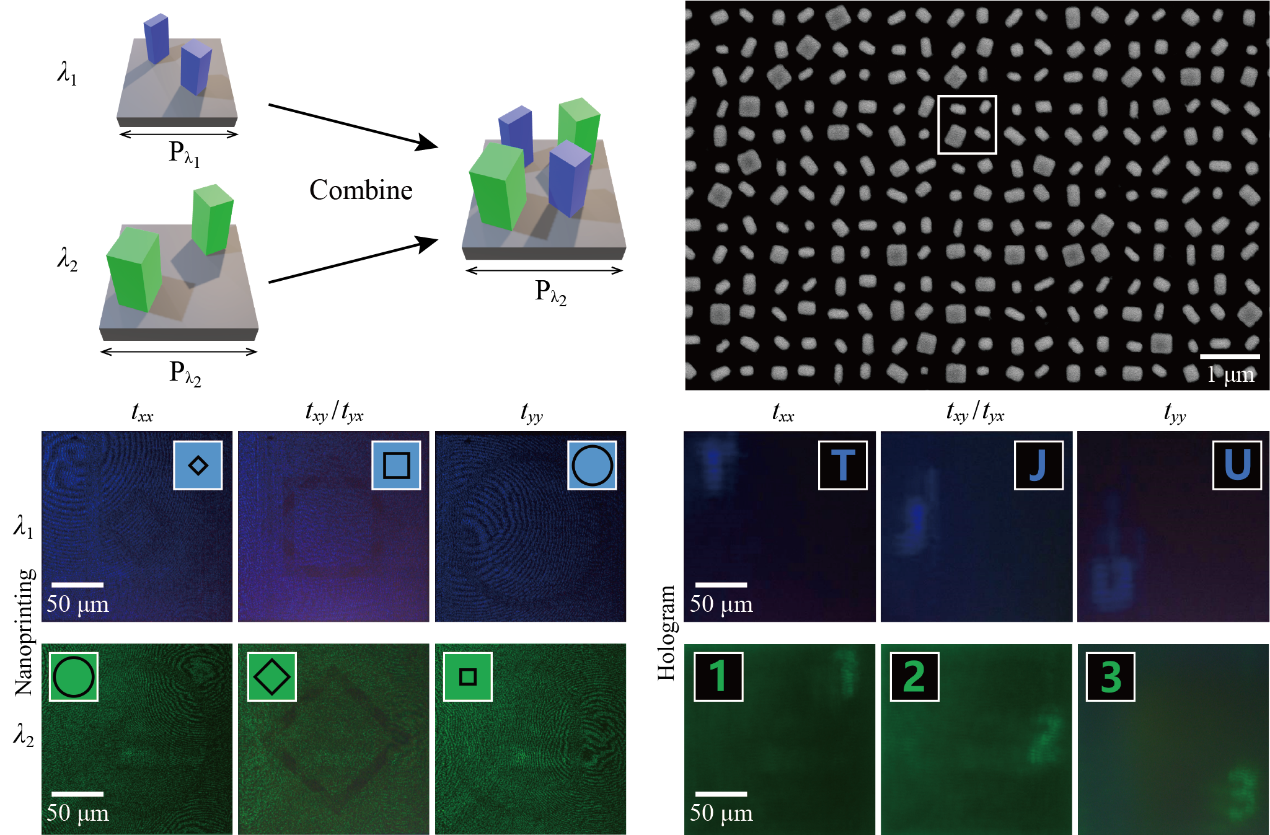
Phase, amplitude, and polarization are the three fundamental degrees of freedom of the monochromatic optical field. Modulation of the optical device on the monochromatic optical field can be represented by a 2×2 Jones matrix. Each component of the Jones matrix represents the transmission coefficient of a specific combination of polarization states, consisting of an amplitude channel and a phase channel. The number of controllable channels of the Jones matrix not only represents the modulation ability for electromagnetic waves of the optical device, but also limits the complexity of the final optical function that can be achieved. With the development of modern optical technology, optical devices are required to be able to load as many Jones matrix channels as possible to achieve complex optical functions, such as polarization switching imaging, optical encryption, and information encoding. However, some of these functions cannot be realized with conventional optical devices such as mirrors and lens, and some require multiple conventional devices to be cascaded, which is not conducive to the miniaturization and integration of optical systems.
Metasurface is a two-dimensional optical device made of arranged artificial subwavelength nanostructures, which has received a lot of attention from researchers in recent years because of its ability to arbitrarily design the phase, amplitude, and polarization of electromagnetic waves at subwavelength scales and its natural characteristics of planarization and easy integration. Metasurface has great potential advantages in Jones matrix manipulation, however, how to control as many Jones matrix channels as possible while taking optical efficiency and spatial resolution into account, is one of the important problems currently faced.
Figure 1 shows the comparison of the relevant representative work on metasurface, including the number of controllable Jones matrix channels, the theoretical spatial resolution and the number of required nanopillars. Early research on metasurface focused on the modulation of single channel, where amplitude/phase modulation phenomena such as perfect absorption, anomalous deflection, and planar focusing can be achieved by special design of the size and shape of the meta-atom. The introduction of rotation angle to realize the co-modulation of propagation phase and geometric phase can realize dual-channel optical functions, such as chiral hologram and vector light field. Four-channel modulation, i.e., the amplitude and phase decoupling modulation of two Jones matrix components, can be further realized by the optical field interference effect of multiple structures. A recent study has achieved the first six-channel modulation of the Jones matrix by designing four identical nanopillars with different spatial coordinates and rotation angles, reaching the upper limit of the theoretical capability of manipulating the Jones matrix in two-dimensional optical devices. However, this detour phase mechanism based on spatial position can only act on higher-order diffracted light, and not only the optical efficiency is greatly reduced, but also the spatial resolution of the super-surface unit is limited by the theoretical limit of wavelength.

Figure 1. Comparison of the number of controllable Jones matrix channels, the theoretical spatial resolution and the number of required nanopillars.
In view of this, Prof. Xinbin Cheng and Prof. Zhanshan Wang from the School of Physical Science and Engineering of Tongji University, together with Prof. Din Ping Tsai from the Department of Electrical Engineering of the City University of Hong Kong, have proposed a new mechanism based on diatomic metasurface to realize high-efficiency and high-resolution Jones matrix six-channel decoupling modulation. By designing the geometry and rotation angle of two high-transmittance nanopillars, the polarization-related interference effects of the output light fields from the two nanopillars can be controlled, and then a fully decoupled regulation with three amplitude channels covering 0~1 and three phase channels covering 0-2π can be achieved (as shown in Figure 2). The method overcomes the shortage of detour phases in the existing methods, the theoretical spatial resolution is unlimited, and the optical efficiency of the metasurface is effectively improved because it can act on zero-order diffracted light. Based on the proposed concept, the paper demonstrates the integration of three nanoprinting images and three holographic images at the wavelength of 532 nm (as shown in Figure 3), and the optical efficiencies of the three holographic images are 15.6%, 16.4% and 17.2%, respectively, which verify the effectiveness of the concept.

Figure 2. Principle of diatomic metasurface: Fully independent modulation of three amplitude channels and three phase channels.

Figure 3. Single-wavelength six-channel Jones matrix modulation: top view SEM of the sample and image measurement results.
In addition, due to the diagonal placement of two nanopillars within a square pixel in the proposed diatomic meta-atom, interleaved multiplexing of two diatomic systems designed for different wavelengths respectively can extend single-wavelength six-channel Jones matrix modulation to dual-wavelength twelve-channel modulation without changing the spatial resolution. The paper demonstrates the twelve-channel integration of six nanoprinting images and six holographic images at the wavelengths of 450 nm and 532 nm (as shown in Figure 4), and the experimental and theoretical results are in good agreement.

Figure 4. Dual-wavelength twelve-channel Jones matrix modulation: top view SEM of the sample and image measurement results.
This work proposes an innovative method to realize the six-channel independent modulation of Jones matrix, which improves the optical efficiency and spatial resolutions, and has excellent potential in ultra-high density optical coding and ultra-compact multi-dimensional modulation of optical fields.
The results were published as a cover article in Laser & Photonics Reviews with the title "Diatomic metasurface for efficient six-channel modulation of Jones matrix". Tao He (a postdoctoral fellow from Tongji University), Professor Zhanshan Wang (from Tongji University), Professor Dingping Cai (from the City University of Hong Kong), and Professor Xinbin Cheng(from Tongji University), are co-corresponding authors of the paper. Chao Feng (a postdoctoral student at Tongji University) and Tao He are co-first authors of the paper. Collaborators with outstanding contributions to the paper also include Yuzhi Shi (a professor from Tongji University), Qinghua Song (an assistant professor from the Shenzhen International Graduate School of Tsinghua University), Jingyuan Zhu (a postdoctoral fellow from Tongji University) and Jian Zhang (a postdoctoral student from Tongji University).
Information of the paper:
Feng, C.; He, T.; Shi, Y.; Song, Q.; Zhu, J.; Zhang, J.; Wang, Z.; Tsai, D. P.; Cheng, X. Diatomic Metasurface for Efficient Six‐Channel Modulation of Jones Matrix. Laser Photonics Rev. 2023, 17(8): 2200955.
https://doi.org/10.1002/lpor.202200955
